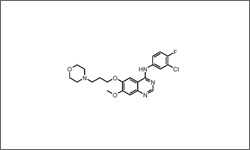Gefitinib

Gefitinib was aproved by the FDA in 2003 as a third line therapy for non-small cell lung cancer that is unresponsive to certain chemotherapy drugs, as it primarily binds to plasma proteins to take effect. Iressa® is administered as an oral tablet.1
- 1 Chu, E., & DeVita, V. T. (2015). Physicians' cancer chemotherapy drug manual 2015. Burlington, MA: Jones & Bartlett Learning.
Gefitinib (Iressa®) is a tyrosine kinase inhibitor. It works to inhibit the epidermal growth factor receptor (EGFR) pathway and any negative signaling found there. EGFR is a receptor found on the cell surface that binds EGF protein, and phosphorylates (adds a phosphate group) tyrosine residues of proteins in a signal pathway. Gefitinib binds the EGFR within the cell and blocks the tyrosine kinase, switching off the EGFR signal, which disallows the cancer cell to grow. 1
The diagram below shows the 3D molecular structure of Gefitinib.
- 1 Chu, E., & DeVita, V. T. (2015). Physicians' cancer chemotherapy drug manual 2015. Burlington, MA: Jones & Bartlett Learning.
